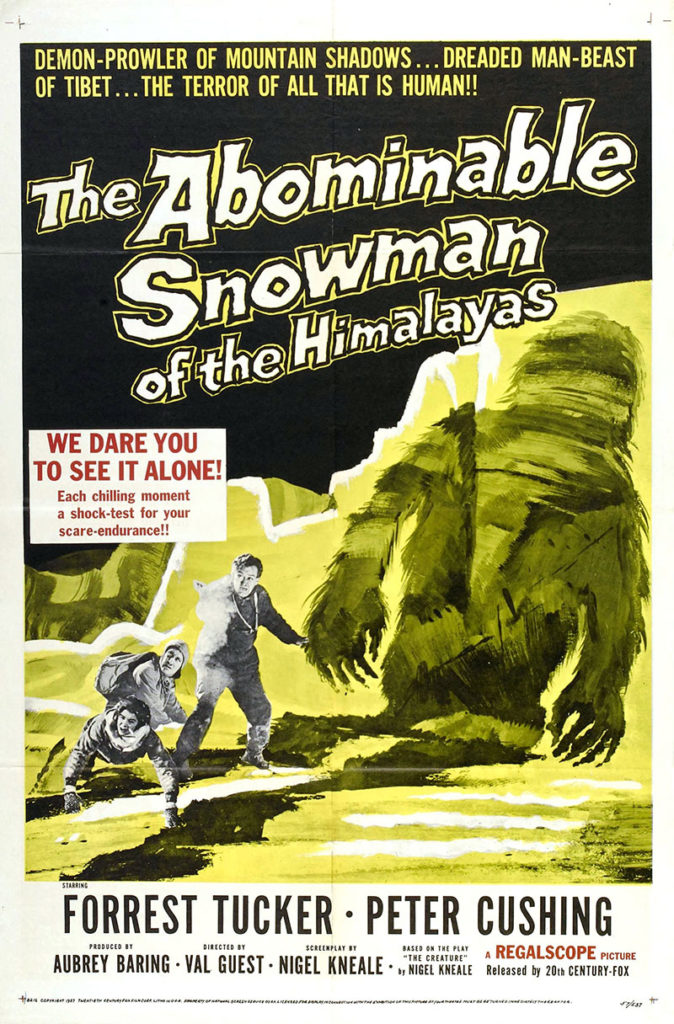The Abominable Snowman, director Val Guest’s film from 1957, has sort of fallen through the cracks. Well, most Hammer films have fallen through the cracks in one way or another, but this flick is the most obscure of those I have seen so far this month. Hammer has a legendary reputation when it comes to their horror. Much of the films aren’t great, but Hammer was persistent and fertile, never going more than a few months before bringing audiences something new. But their catalogue has been mistreated, much of it only available on out of print, and thus hard to find, DVDs and VHS tapes. The big flicks are available in places like Prime and iTunes, but if one wishes to watch something like The Abominable Snowman without searching for physical media, the options, and quality, are very limited.
The Abominable Snowman is another film adaptation of a BBC production. As with the Quatermass films, the original production, titled The Creature, was written by Nigel Kneale, who again adapted his own work for the film version. Having seen a number of these BBC to Hammer films at this point, I can make a few predictions. One: not much is going to happen. The BBC had even smaller budgets than Hammer, so their original productions are very dialogue heavy. This made them attractive properties for Hammer, because they could make their own versions on the cheap. Two: don’t expect to see a Yeti until the end, and then only briefly. The money just isn’t there. Many films fall into the trap of showing the monster too much and ruining their tension. That was never an issue with these early Hammer flicks. But, considering I’m weeks into this month of reviews and all the monsters have looked, at least, borderline laughable, that might not be a bad thing.
The film stars Peter Cushing as Dr. John  Rollason, a botanist, I think, who has become somewhat enamored by the legend of the Yeti, the cryptozoological great ape of the Himalayas. How fortunate for Rollason that he happens to be at a remote monastery in the Himalayas as the film opens. He is there ostensibly carrying out his normal research, but he has been in communication with American researcher/adventurer Dr. Tom Friend (Forrest Tucker), who is bringing a small climbing expedition to the area to hunt the Yeti. Rollason joins Friend’s team, and off they go on their search, despite the warnings of the khenpo of the monastery.
Rollason, a botanist, I think, who has become somewhat enamored by the legend of the Yeti, the cryptozoological great ape of the Himalayas. How fortunate for Rollason that he happens to be at a remote monastery in the Himalayas as the film opens. He is there ostensibly carrying out his normal research, but he has been in communication with American researcher/adventurer Dr. Tom Friend (Forrest Tucker), who is bringing a small climbing expedition to the area to hunt the Yeti. Rollason joins Friend’s team, and off they go on their search, despite the warnings of the khenpo of the monastery.
What follows is a fruitful search for the Yeti. No ambiguity here. It doesn’t take long for the expedition to find signs of the creature’s existence. And that’s because, more than anything else, this film is about human morality. Rollason represents the curiosity of humankind, while Friend and his compatriots represent rashness and our inherent destructiveness (the fact that Friend is a loudmouthed American won’t be lost on any viewers — Hammer loved that trope). The push and pull between war and peace in this small slice of mountainous landscape is the true story of this movie.
Again, this probably goes back to the resources the filmmakers had on hand. If there isn’t the budget for a monster, then tension has to come from elsewhere. In the previous review this month, for Quatermass and the Pit, I wrote about the superfluous nature of many films’ resident shitheads. That is, there is usually enough plot in flicks like this involving a protagonist and a monster that introducing another source of tension, in the form of an ignorant shithead, is not needed. In this film, Friend is the shithead, but this character is anything but superfluous. In fact, he is essential, otherwise the entire film would have been Peter Cushing wandering around in the snow waiting for something to happen. The point/counterpoint of Rollason and Friend is the film.
Despite its small ambitions, The Abominable Snowman is satisfying. There is no grand spectacle at all to this film. Its origins as a television play are obvious, meaning many viewers may be gnashing their teeth waiting in vain for the film to take off. It never really does so, but I enjoyed most of it. My attention did begin to wane near the end, however. This film is an archaeological specimen, interesting only to those interested in Hammer Film Productions. Otherwise, its growing obscurity makes sense.
